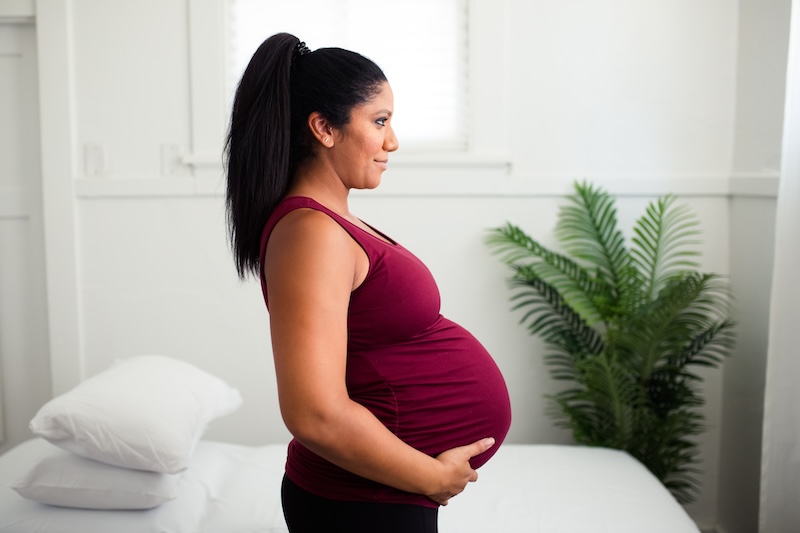Upper Back Pain in Pregnancy? Try These 5 Stretches ASAP
Pregnancy can be an amazing journey, but let’s be real — it can also be a total pain in the back…literally! If you’re experiencing upper back discomfort, you’re not alone. Around 42% of pregnant women will have upper back pain. But as your body changes to grow a baby, pain is bound to happen. Luckily, it doesn’t have to stay that way. Keep reading to learn about upper back pain in pregnancy and some effective strategies to manage your symptoms.
Upper back pain in pregnancy: Causes
Several factors contribute to upper back pain during pregnancy:
- Postural changes: Your growing belly and breasts reshape how you stand, sit, and move. Your center of gravity shifts forward, straining the curves in your upper and lower back and putting pressure on your sciatic nerve. (Hello low back pain!)
- Hormonal changes: Relaxin helps your body to adjust to pregnancy, and prepares it for birth by softening ligaments. But it also increases joint mobility and forces your muscles to work harder.
- Rib cage and breathing changes: A growing uterus causes lower rib expansion and pressure on your diaphragm. This also means more chest breathing, differences in muscle engagement, and additional strain on back and rib muscles.
- Body weight changes: The extra weight of pregnancy may put additional stress on your back muscles, shoulders, and the joints throughout your entire back.
- Muscle fatigue: Your body works harder to support your growing baby, leading to muscle spasms and upper back pain.
- Movement pattern alterations: Pregnancy-related changes lead to altered muscle activation and potential overuse.
There are also some more unexpected culprits, including:
- Changes in your usual sleep positions
- Modified exercise routines
- Added stress, which can cause a surprising amount of muscle tension and pain
Symptoms
Upper back pain during pregnancy can feel like:
- Dull or sharp aches and pain between your shoulder blades and in your thoracic spine
- Tight muscles/stiffness in your upper back, shoulders, and neck with limited range of motion
- Pain radiating to your chest, arms, or causing headaches
- Possible numbness or tingling in the arms or hands
Symptoms can range from mild to severe and can feel worse with prolonged sitting or standing. You may also find difficulty in breathing deeply or maintaining a neutral spine.
Check your posture
Start by looking in a mirror. (You look fabulous by the way!) Then, practice nailing your posture in all of the following postures and movements.
Standing:
- Stand up straight with feet shoulder-width apart, knees slightly bent.
- Create length in your spine, imagining a string pulling the top of your head upward.
- Tuck your chin and drop your shoulders back and down.
- Gently pull in your belly to maintain a neutral spine.
- Balance your body weight through the arches of your feet.
Sitting:
- Sit up straight with pressure evenly through your sit bones.
- Keep your chin neutral and shoulders down and back.
- Use lumbar support pillows for good back support.
- Keep feet flat on the floor with knees and hips at 90 degrees.
Sleeping:
- Lie on your left side for best circulation. Place a pillow between your knees and a thin pillow under your belly. You can also put a pillow behind your back for comfort. We love this pregnancy pillow!
- Lay on your back in a semi-reclined position. Stack pillows behind your head, upper back, and under your knees.
Lifting and bending:
- When carrying bags, distribute weight evenly between hands.
- Push objects instead of pulling them.
- Squat or lunge when picking things up, rather than bending at your waist.
- Bend your knees and use your legs, not your upper back and arms.
Exercises and pregnancy stretches for back pain relief
It can help to stay active during your pregnancy with things like prenatal yoga or other exercises you have been doing, which have been cleared by your OBGYN. Here are a few exercises to inspire you!
1. Cat-cow stretch
Start on your hands and knees, with knees under hips and hands under shoulders:
- Inhale, then arch your back, drop your belly toward the floor, and lift your chest and chin forward (cow pose). Focus on opening your upper back.
- Exhale, round your back, tuck your chin toward your chest, and gently press through your hands to spread your shoulder blades (cat pose).
- Move slowly between these poses for 5–10 breaths.
2. Chin tucks
Sit up straight with your shoulders down and back and feet flat on the floor:
- Gently tuck your chin toward your neck, creating a “double chin” while keeping your gaze forward. Hold for 5 seconds.
- Relax and return to the starting position. Repeat 5–10 times.
3. Shoulder blade squeezes
While standing, bend your elbows and hold a band in each hand:
- Pull on the band and rotate your hands away from each other, gently squeeze your shoulder blades together. Keep your shoulders down and away from your ears.
- Hold the squeeze for 5 seconds, then relax.
- Repeat 10–15 times.
4. Seated transverse abdominis contractions
Sit upright with your knees bent and feet flat on the floor:
- Take a deep breath in. As you exhale, gently draw your belly button toward your spine, engaging your core muscles without tilting your pelvis or holding your breath.
- Hold the contraction for 5-10 seconds, then relax.
- Repeat 10-15 times.
5. Seated thoracic spine extension
Sit upright in a chair with your feet flat on the floor and hands clasped behind your head:
- Inhale and gently arch your upper back over the chair’s backrest, keeping your lower back stable.
- Exhale as you return to the starting position.
- Repeat 5-10 times, focusing on smooth, controlled movements through your upper back.
When to see your doctor immediately
Luckily, upper back pain during pregnancy isn’t usually a cause for serious concern. But get medical attention immediately if you develop upper back pain and have a history of high blood pressure or preeclampsia — especially if you have other symptoms of preeclampsia like unexplained swelling in your hands and face, a headache that won’t go away, and vision changes.
Join the V-Hive for comprehensive pregnancy support
Don’t suffer in silence. If your pain is sticking around despite the suggestions above, reach out to your OBGYN or a physical therapist for more help. You can schedule an online consultation with one of our physical therapists to chat about your symptoms today.
Or, check out our comprehensive Pregnancy Program in the V-Hive, which guides you through safe and effective exercises. It’s designed specifically for what your body needs during pregnancy and is created by a physical therapist.
By joining the V-Hive, you’ll gain access to expert guidance and the support to keep your whole body strong and healthy throughout pregnancy and beyond. Don’t let upper back pain hold you back — take control of your pregnancy wellness today with the V-Hive!










